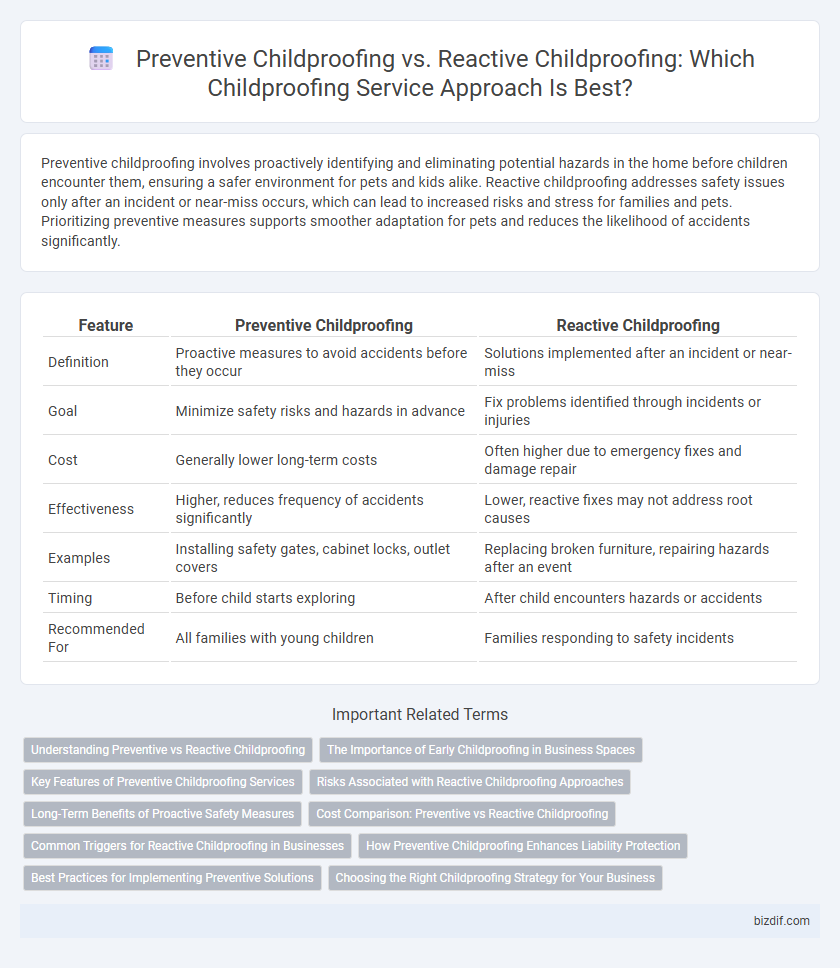Preventive childproofing involves proactively identifying and eliminating potential hazards in the home before children encounter them, ensuring a safer environment for pets and kids alike. Reactive childproofing addresses safety issues only after an incident or near-miss occurs, which can lead to increased risks and stress for families and pets. Prioritizing preventive measures supports smoother adaptation for pets and reduces the likelihood of accidents significantly.
Table of Comparison
| Feature | Preventive Childproofing | Reactive Childproofing |
|---|---|---|
| Definition | Proactive measures to avoid accidents before they occur | Solutions implemented after an incident or near-miss |
| Goal | Minimize safety risks and hazards in advance | Fix problems identified through incidents or injuries |
| Cost | Generally lower long-term costs | Often higher due to emergency fixes and damage repair |
| Effectiveness | Higher, reduces frequency of accidents significantly | Lower, reactive fixes may not address root causes |
| Examples | Installing safety gates, cabinet locks, outlet covers | Replacing broken furniture, repairing hazards after an event |
| Timing | Before child starts exploring | After child encounters hazards or accidents |
| Recommended For | All families with young children | Families responding to safety incidents |
Understanding Preventive vs Reactive Childproofing
Preventive childproofing involves proactively identifying and eliminating hazards before children encounter them, ensuring a safer environment from the outset. Reactive childproofing addresses safety concerns after incidents or near-misses have occurred, often requiring immediate adjustments based on observed dangers. Understanding the distinction between these approaches helps caregivers implement comprehensive safety strategies that minimize risks effectively.
The Importance of Early Childproofing in Business Spaces
Early childproofing in business spaces significantly reduces the risk of accidents by proactively addressing hazards such as sharp edges, electrical outlets, and toxic substances. Preventive childproofing involves comprehensive safety assessments and installations before incidents occur, ensuring a secure environment that complies with safety regulations and fosters customer trust. Reactive childproofing, implemented after an accident, often results in higher costs and potential legal liabilities, highlighting the importance of timely preventive measures.
Key Features of Preventive Childproofing Services
Preventive childproofing services emphasize proactive measures such as installing safety gates, securing cabinets, and covering electrical outlets before accidents occur, reducing injury risks significantly. These services include thorough home safety inspections to identify potential hazards early, ensuring comprehensive protection tailored to the child's age and developmental stage. Preventive childproofing also integrates the latest safety technology and durable materials, guaranteeing long-term effectiveness and peace of mind for parents.
Risks Associated with Reactive Childproofing Approaches
Reactive childproofing often occurs after an incident, increasing the risk of injuries due to unaddressed hazards present during the delay. This approach overlooks the benefits of proactive measures that identify and mitigate dangers before children encounter them, such as securing sharp objects or toxic substances. Studies show that homes employing preventive childproofing report significantly fewer emergency room visits, emphasizing the critical risks linked with reactive strategies.
Long-Term Benefits of Proactive Safety Measures
Proactive childproofing minimizes risks by addressing potential hazards before accidents occur, ensuring a safer environment for children over time. Implementing preventive measures reduces medical expenses, emergency interventions, and emotional distress caused by injuries. Long-term safety investments promote peace of mind for parents while fostering healthy child development and secure exploration.
Cost Comparison: Preventive vs Reactive Childproofing
Preventive childproofing typically incurs lower overall costs by addressing potential hazards early, reducing the likelihood of expensive medical treatments and extensive home repairs. Reactive childproofing often leads to higher expenses, as it involves fixing damage or injuries after accidents have occurred, which can include emergency room visits and structural modifications. Investing in preventive measures such as outlet covers, cabinet locks, and stair gates proves more cost-effective than responding to preventable incidents.
Common Triggers for Reactive Childproofing in Businesses
Reactive childproofing in businesses often addresses common triggers such as frequent employee accidents, areas with sharp edges, and locations where hazardous materials are stored improperly, leading to safety incidents. These triggers necessitate immediate intervention to reduce liability and improve workplace safety after an incident has occurred. Preventive childproofing proactively identifies and mitigates risks before accidents happen, minimizing disruptions and enhancing overall security.
How Preventive Childproofing Enhances Liability Protection
Preventive childproofing reduces the risk of accidents and injuries by addressing potential hazards before they cause harm, thereby minimizing legal exposure for property owners and caregivers. Implementing thorough safety measures in advance demonstrates due diligence and compliance with safety standards, which strengthens liability protection in the event of an incident. Proactive safety interventions significantly lower the chances of costly lawsuits and insurance claims related to child injuries.
Best Practices for Implementing Preventive Solutions
Implementing preventive childproofing solutions involves proactively identifying hazards such as sharp corners, electrical outlets, and toxic substances before accidents occur. Best practices include securing furniture to walls, installing safety gates, and using outlet covers to minimize risks effectively. Regularly updating safety measures and educating caregivers on potential dangers ensures a safe environment for children.
Choosing the Right Childproofing Strategy for Your Business
Preventive childproofing involves proactively identifying and mitigating potential hazards before incidents occur, ensuring a safer environment for children from the outset. Reactive childproofing addresses safety concerns only after an incident or near-miss has highlighted vulnerabilities, potentially exposing businesses to higher risks and liabilities. Selecting the right childproofing strategy for your business depends on balancing cost, legal compliance, and risk management, with preventive measures generally offering greater long-term protection and peace of mind.
Preventive childproofing vs Reactive childproofing Infographic

 bizdif.com
bizdif.com